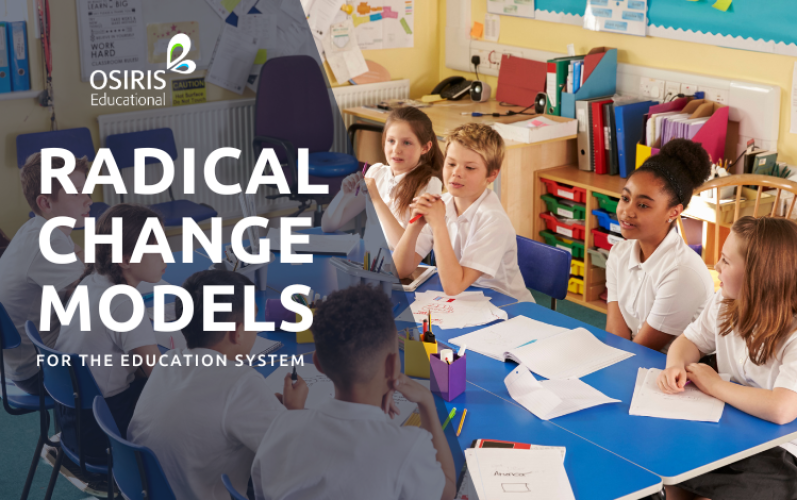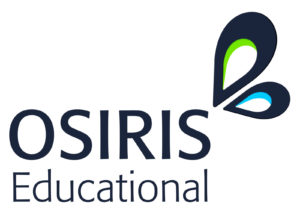Menu
Radical Change Models in the Education System
A blog from Osiris Educational

Radical Change Models in the Education System
I have been on the beautiful planet for nigh on 60 years and directly involved in education for 55 of them.
I have been called the biggest pessimist and the biggest optimist.
And during that time, I have been fortunate to travel the globe meeting learners, teachers, leaders, and leading professors. As a company we have trained more than 500,000 teachers across 18,000 schools and 110 countries.
Leaving a conference in Bucharest last week, I am left wondering whether it is time to ‘Rip it Up and Start Again’ (Orange Juice 1982) or stick and trust to iterative development. Here’s an exploration of both perspectives and potential solutions.
What’s Wrong with the Current System? (Pessimist Perspective)
- Imminent Climate Crisis: We are facing an impending global climate disaster. The heat is only just beginning, and we are completely underprepared – unless you are very rich and live in a ‘defended territory.’
- Mental Health Epidemic: There is a widespread crisis of anxiety, mental health issues and stress. Stressed teachers pass on their stress to their learners and the culture of “faster, stronger, harder” fuels the problem. Additionally. The future stored health costs are significant as highlighted in “The Body Keeps the Score” by Van der Kolk.
- Growing Social Inequality: Social Inequality is growing rapidly, with implications for those less fortunate (the ‘have-nots’ – see Gary’s Economics for more details).
- Erosion of Trust in Education: Trust in the education system is being eroded. Two-thirds of students are directly affected by absenteeism, and many learners (often supported by parents) are choosing not to attend school.
- Funding Diverted from Education: Central funding is being diverted to ‘more pressing issues’, meaning education goes missing from political agendas in both the UK and the USA.
- Short Political Cycles: Political cycles are too short, and the knee-jerk ‘vote winning whims’ put forward as policies are not fit to run education.
And What is Going Right? (Optimist Perspective)
- Climate Catastrophe Awareness with Action: There is a growing recognition of the imminent climate crisis, with youth actively putting their hearts and actions into solutions. Teachers have long been at the vanguard of raising awareness. Innovations like micro turbines, solar energy, wind farms and many other technical solutions are advancing rapidly.
- Pathways to Wellness in the Mental Health Epidemic: Thanks to the likes of Van der Kolk, Sadhguru and Gabor Mate we are understanding the net causes. Joyfulness is the antidote. We can teach breathwork, meditation and mindfulness to calm anxious young minds. Work and research on balancing Adverse Childhood Experiences (ACEs) is accelerating.
- Social Inequality has righted itself: It is fair to say that it has taken wars, famine and revolution but there are mechanisms.
- Restoration of Trust in Education: Trust once broken is hard to mend, but dedicated teachers and youth workers apply themselves to just that challenge daily. Endeavours like Everton in the Community School and many others demonstrate what’s possible and offer a model for success. Research shows that the number of hours a child spends in formal education has a direct correlation with health, wealth and happiness.
- Central Funding will Swing Back into Education: Education emphasis does tend to turn in cyclical trends. In many countries, demographics suggest less strain on the current system. However, the lower birth rate may bring other problems (aging population, lower economic growth).
- Short Political Cycles May Not Continue: Younger generations appear to be increasingly shifting away from the “growth-at-any-cost” mindset that has dominated previous generations.
Proposed Radical Solutions for the Future of Education
- Join the AI Revolution
Let AI and large language models take over teaching, tutoring and assessment. Many believe this has the potential to revolutionise education, making schools as we know them obsolete.
Others are more circumspect, suggesting that AI may just become an 8th wave of digital technology that fails to significantly alter/improve the offering of schools.
Undoubtedly the truth lies somewhere in between. Smaller, tentative steps marked by prohibitionists and evangelists.
If you’re ready to explore how to harness this transformative technology in practical, impactful ways, consider joining our course Leading AI in Education to navigate and lead the AI revolution in schools.
- Privatise the Schooling System
Children in the USA are already opting out of the traditional schools system at a rate of 7% per year. One option is to deregulate the entire system, allowing needs to be met through a mix of local provision and national chains. Parents would pay, with tax adjustments to help cover the cost and make it more accessible.
This isn’t the first time I have come across such an idea from eminent thinkers. And it obviously has not gone away. But if there were an avoidable choice between privatisation of the NHS (UK) or the Education system, which would be preferable??
The key problem, aside from lack of political will, would be the dangers posed by growth of inequity and social division. Education is much more like building cathedrals than making sandwiches.
- Learners in Charge
Invert the model and put the learners in charge, building a system around their needs.
We are already seeing changes in patterns of desire and agency in ways that would previously have been suppressed. Children thrive on complex. “wicked” problems; give them the ones where their skin is firmly in the game and then support them to make it happen.
There are already emerging models from community schools where all ages are regarded as active learners who participate equally.
Why not make children’s first experience of institutions be democratic and enabling. Whether the adults in the system would have the flexibility to cope is a moot point.
- Open School
A flexible network that combines academic courses of your choice with learner coaching and an enrichment programme that spans community to international.
Many elements of this already exist: Sal’s Khan Academy boasts huge enrolment numbers and courses, there is the integration of AI, and it has already moved into university-level teaching.
Support this with personal learning coaches to help with pathways and dedicated support and add on the largest and most sophisticated opportunity (extra-curricular) offering (both in person, in community and online)
This looks like the most feasible option. Particularly to support those already starting to opt out. There is a lot of political kickback, but viable models are already emerging.
- Overhaul Assessment
Throw away the exam boards, university entrance system and text books.
This simpler offering takes away the huge business interests that wag the tail of the school system dog.
Universities could relatively easily set their own tests, interview processes and aptitude analysis rather than relying on vague predictions in what remain largely tests of factual recall. And that could be far more inclusive of inequity and late developers.
Many commentators think this is long overdue. Open assessment (with access to resources) has already proven itself and collaborative assessment models balance the power of collective against individual focused testing. Freed from the almost complete predominance of knowledge recall the curriculum could metamorphosize itself.
However awarding bodies and text-book/resource publishers have deep pockets and established lobbying system so don’t hold your breath for the Turkeys to vote for Christmas.
Smaller and Less Radical Iterations
Not every solution has to be radical. Here are incremental changes with potential:
- Changing the inspection process: to support growth rather than punitive measures.
- Focus the system on learner development: emphasising critical thinking and emotional intelligence.
- Eliminate teaching assistants: Many schools have more teaching assistants (TAs) than teachers, with very low effect size. By investing three years to enable all TAs to qualify as teachers, we could address both the surplus of TAs and solve the teacher shortage.
- Pay teachers a lot more: Better compensation can attract and retain passionate educators.
- Remove all labels: studies shows that they often have a negative impact (effect size -0.6). Adults should also avoid labelling themselves based on these effects. We are all atypical in one way or another.
- Give every child a learning intervention: thereby abandoning the stigma associated with SEND labels. Additionally, adults can access support if they want to.
- Move to inquiry and project-based curriculums: (the jury is still out on that one) Though debated, this model could enhance engagement and deep learning. See Inquiry Based Learning for more information.
Conclusion: Education at a Crossroads
Our education system faces unprecedented challenges, yet there is also unprecedented potential for positive change. Whether we choose a revolutionary approach or incremental adjustments, one thing is clear: Education must evolve to meet the demands of an ever-changing world.

